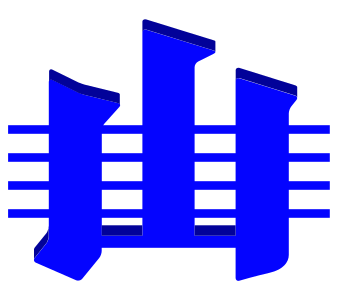GSSP of the Coniacian Stage
Definition
The GSSP for the base of the Coniacian Stage is defined by the first occurrence of the inoceramid Cremnoceramus deformis erectus (Meek, 1877) at the base of Bed 46 at Salzgitter-Salder (Lower Saxony Basin, Germany) [Note that it is one bed below Bed 47, which was formerly regarded as the entry level of C. deformis erectus and thus the base of the Coniacian Stage]. The first appearance of C. deformis erectus follows shortly the first appearance of its evolutionary predecessor, C. waltersdorfensis waltersdorfensis, which marks the main turnover events in evolutionary history of the clade around the base of the Coniacian.
Location
The GSSP section (geographic coordinates: 52.1243°N, 10.3295°E) is located south of the A39 motorway between the town of Braunschweig and the Autobahn junction ‘Salzgitter’ near the exit to the town of Salzgitter-Salder. The quarry is situated in the southern, steeply north-northeastward dipping (c. 70°) flank of the asymmetrical Lesse Syncline, adjacent to the 10 Salzgitter-Lichtenberg structure.
Sedimentology
The Salzgitter-Salder section exposes a c. 220 m thick middle Turonian–lower Coniacian succession of well-bedded carbonates belonging to the Söhlde, Salder, and Erwitte Formations. The latter consists of the Grauweisse Wechselfolge (Grey and White Alteration) Member succeeded by the Upper Limestone Member. The Turonian–Coniacian boundary interval constitutes the upper part of the Grauweisse Wechselfolge and its turnover to the Upper Limestone Member.
Primary Marker
The FO of the inoceramid Cremnoceramus deformis erectus (Meek, 1877) at the base of Bed 46.
Secondary Markers
Listed below from the stratigraphic bottom to the top (Abbreviations: LO= Lowest Occurrence; HO= highest occurrence; FAD= first appearance datum; CIE= Carbon Isotope Event)
Beds 35b–36: Two positive carbon isotope peaks, referred to collectively as the ‘i5’ Event. Beds 39b–45b: The Navigation Carbon Isotope Event Option 2. Bed 39b: The lower acme occurrence of the bivalve Didymotis, which is the Didymotis I Event. Bed 41: The LO of the ammonite Forresteria petrocoriensis (projected from the Słupia Nadbrzeżna auxiliary section). Bed 42: The LO of the planktonic foraminifer Dicarinella concavata (projected from the El Rosario and Słupia Nadbrzeżna auxiliary sections). Beds 42a–45b: The Navigation Carbon Isotope Event Option 1. Bed 44: The HO of the inoceramids Mytiloides herbichi and Mytiloides scupini. Bed 45a. The LO of the inoceramid Cremnoceramus waltersdorfensis waltersdorfensis and the bivalve Didymotis II Event. Bed 46: The LO / FAD of the inoceramid Cremnoceramus deformis erectus; the base of the Coniacian Stage. Top of Navigation CIE. Bed 47a: The lowest acme occurrence of Cremnoceramus deformis erectus, which is the erectus I Event. Bed 49a: A higher acme occurrence of Cremnoceramus deformis erectus, which is the erectus II Event; the positive CIE, which is the ‘i6’ Event. Bed 52b: The LO / FAD of the inoceramid Cremnoceramus waltersdorfensis hannovrensis. Bed 53a: The third acme occurrence of Cremnoceramus deformis erectus, which is the erectus III Event. Bed 55–58: The positive CIE, which is the ‘i7’ Event. Bed 62: The HO of the calcareous nannofossil Helicolithus turonicus. Beds 69-70: The positive CIE, which is the ‘i8’ Event. Bed 73: The LO / FAD of the inoceramid Cremnoceramus crassus inconstans.
Geochronology
The age estimate for the base of the Coniacian derived from an astrochronologic framework of the Niobrara Formation anchored with radioisotopic data (40Ar/39Ar and U-Pb) from the Kevin–Sunburst Dome area of Montana is 89.75 ± 0.38 Ma (after Sageman et al., 2014).
Correlation Events
The biostratigraphic markers used to recognise the base of the Coniacian are largely recognisable across the entire Euramerican Biogeographic Province. The best represented marker is the LO of the primary marker Cremnoceramus deformis erectus, which usually occurs in a quite distinct succession: Mytiloides herbichi – Cremnoceramus waltersdorfensis waltersdorfensis – Cremnoceramus deformis erectus.
Auxiliary Sections
Słupia Nadbrzeżna (central Poland; geographic coordinates: 50.9504°N, 21.8071°E; Walaszczyk et al. 2010) This section offers the best and apparently most complete inoceramid record across the boundary and within the boundary interval. It has also yielded some ammonites, including a record of the critical taxon Forresteria petrocoriensis.
Střeleč railway cut section (Bohemia, Czech Republic; geographic coordinates: 50.4967°N, 15.2551°E; Čech and Uličný, 2021). It provides essentially the same biostratigraphic record of the Słupia Nadbrzeżna section, but in a complementary depositional system strongly affected by terrigenous clastic input.
El Rosario section (Sierra del Carmen National Park, Coahuila, Mexico; geographic coordinates: 29.0294°N, -102.4617°W; Ifrim et al. 2014, 2019). It provides details of the boundary record from an area close to the southern entrance to the North American Western Interior Seaway. It confirms the synchroneity of the inoceramid record throughout the Euramerican Biogeograpic Region, and yields a rich ammonite faunal succession that is unmatched in any other Turonian–Coniacian boundary locality.
Links
Ireneusz Walaszczyk, Stanislav Čech, James S. Crampton, Zofia Dubicka, Christina Ifrim, Ian Jarvis, William J. Kennedy, Jackie A. Lees, Damian Lodowski, Martin Pearce, Danuta Peryt, Bradley B. Sageman, Poul Schiøler, Jordan Todes, David Uličný, Silke Voigt, Frank Wiese, with contributions by Christian Linnert, Tobias Püttmann, Seiichi Toshimitsu (2022). The Global Boundary Stratotype Section and Point (GSSP) for the base of the Coniacian Stage (Salzgitter-Salder, Germany) and its auxiliary sections (Słupia Nadbrzeżna, central Poland; Střeleč, Czech Republic; and El Rosario, NE Mexico). Episodes 2022; 45(2): 181-220.https://doi.org/10.18814/epiiugs/2021/021022
